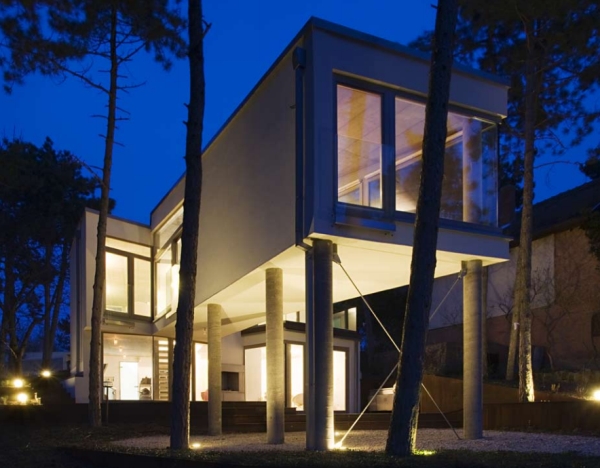Holiday Home at the Lake Balaton
A Nostalgic Report of a Holiday Home in Balatonakarattya
Architects: Éva Fortvingler, Tamás Bulcsu
Text: Zorán Vukoszávlyev PhD
Photos: Tamás Bujnovszky

There is something definitely charming in our calling the largest lake of the country „the Hungarian sea”. Even the younger generations of the turn of the millennia think nostalgically of the vacations their elders spent by the lake experiencing their „sole and utmost wish being realized” – whether it was a family holiday in the atmosphere of the trade unions’ (SZOT) resorts or a weekend relaxing with a party of friends. Photos, images and memories are overwritten and turn even more and more precious, the difficulties of packing up needed to have the experience and the drive on the bumpy concrete slabs of the M7 motorway are sinking into oblivion.
„Balaton” (this way, being elevated into quotation marks) is the old one when disregarding the significant changes that took place concerning comfort and service that rendered the former Balkan-type conditions by changing them into „European” ones. Even if those old ones were better, the motorway has definitely meant a change for the better.
From Budapest today it only takes a short hour to get to the eastern tip of Lake Balaton, so a holiday gome in Balatonakarattya may as well be used as a suburban resort. Built for the purposes of a young family with a dynamic lifestyle the compact villa is used intensively proving the architects’ intention to design it with a unique character. Éva Fortvingler and Tamás Bulcsu applied an approach using a distinguished way of utilizing space, constructing from individual and unique spatial forms, whilst probing the limits of our general view of the contemporary concept of holiday homes. When having the villa designed to serve their mobile lifestyle as much as possible, clients have had an extraordinarily open mind and trust for the architects who are their peers It is surprising to know that the architects’ attitude using solutions that meet international standards have been most fervently opposed by the leading architect protecting the high standards of contemporary Hungarian architecture when licensing the project. Finally it was a decision made by a „clerk”, a head of a department that gave the necessary impetus to the unique design of the young architects which thus did not get lost in the absurd system of criteria concerning the regulations of high roofs.
The lot found by the family with two children reflects the unique geographical faculties of Akarattya: situated on the north-western slope and turning towards the water we can see into the longitudinal axis of Lake Balaton, with the spectacle itself vanishing into the far-away horizons. Chosen together by the family and the architects, the desolation of the tiny building site was counteracted by intensive landscaping and a selective pruning of the vegetation resulting in an environment with a characteristic atmosphere. The naturally gentle and yet strikingly narrow wing of the villa nestles into the heart of the lot deep amongst the tall, column-like pine trees.

We may consider the view opening up with the compulsory front garden with a driveway with pergola as a result of a concealing gesture, but regarding the faculties of the steep terrain architects concentrated on the inner part of the lot and the direction of the view, which justifies the solid wall erected towards the street. Cut deep into the terrain, the stairs lead directly to the garden level where the niches for family life by daytime open up with a fascinating dynamism to the artistically structured garden surface. The latter is a realization of the concept phrased by Új Irány Csoport (New Direction Group) so as to expand living spaces. The tiny building is cut into two in the middle by a block of building supported by columns in the lane of communication leading out to the stepped system of terraces with surfaces suited for having a rest and then melt into the lawn spreading towards the nearby border of the lot at the back. The lyrical magic of pine-trees is fascinating indeed: architects have intensively opened the layout towards this controlled fragment of a forest as the lakeshore and the vast expanse of water are visible amongst the trees. Set in the heart of the building, the fireplace organizes the vertical axis. Placed in the middle and rich in minimalist details, a sculpturesquely beautiful single staircase provides access to the upper floor. Bedrooms ending in backwalls towards the street open up with glazed facades in the direction of the garden. There is a lookout also suited for sitting and even to be used as a spare room: it reaches amongst the slender tree trunks as a composed wedge of large glass surfaces to emphasize the central axis. Almost achingly beautiful, a meditative space is modelled here within the block on plinths. This narrative is slightly pulled back to reality by the thickness of the columns, but the broken character of the composition of the building manages to find its own niche on the hidden hillside with its intensive answers to the issues of its environment. Fortvingler and Bulcsu are citing here the spiritual foundations of Scandinavian organic architecture with their self-conscious environment-awareness, but also reveal the sensitive plasticity of contemporary Spanish architecture meanwhile so as to create a unique world for a young couple suiting their „tend-proving” view of life and offering an interpretation of the Balaton-story in the new millennium.
Architects: Éva Fortvingler, Tamás Bulcsu – munkacsoport.net
Garden: Dominika Tihanyi, Árpád Kovács – uilandscape arhitects
Structural engineer: Anikó Kilián (kiviteli terv), Ákos Medek (eng.terv)
Installation: Róbert Goda







